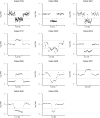Copy-number variations measured by single-nucleotide-polymorphism oligonucleotide arrays in patients with mental retardation
- PMID: 17847001
- PMCID: PMC2227926
- DOI: 10.1086/521274
Copy-number variations measured by single-nucleotide-polymorphism oligonucleotide arrays in patients with mental retardation
Abstract
Whole-genome analysis using high-density single-nucleotide-polymorphism oligonucleotide arrays allows identification of microdeletions, microduplications, and uniparental disomies. We studied 67 children with unexplained mental retardation with normal karyotypes, as assessed by G-banded chromosome analyses. Their DNAs were analyzed with Affymetrix 100K arrays. We detected 11 copy-number variations that most likely are causative of mental retardation, because they either arose de novo (9 cases) and/or overlapped with known microdeletions (2 cases). The eight deletions and three duplications varied in size from 200 kb to 7.5 Mb. Of the 11 copy-number variations, 5 were flanked by low-copy repeats. Two of those, on chromosomes 15q25.2 and Xp22.31, have not been described before and have a high probability of being causative of new deletion and duplication syndromes, respectively. In one patient, we found a deletion affecting only a single gene, MBD5, which codes for the methyl-CpG-binding domain protein 5. In addition to the 67 children, we investigated 4 mentally retarded children with apparent balanced translocations and detected four deletions at breakpoint regions ranging in size from 1.1 to 14 Mb.
Figures




References
Web Resources
-
- Database of Genomic Variants, http://projects.tcag.ca/variation/
-
- ExonPrimer, http://ihg.gsf.de/ihg/ExonPrimer.html
-
- GenBank, http://www.ncbi.nlm.nih.gov/Genbank/ (for MBD5 breakpoint region [accession number EF504248], FOXP1 breakpoint region [accession number EF504249], and MBD5 mRNA [accession number EF542797])
-
- Online Mendelian Inheritance in Man (OMIM), http://www.ncbi.nlm.nih.gov/Omim/ (for 17p11.2 duplication syndrome, Smith-Magenis syndrome, Diamond-Blackfan anemia, and X-linked ichthyosis)
References
-
- Roeleveld N, Zielhuis GA, Gabreels F (1997) The prevalence of mental retardation: a critical review of recent literature. Dev Med Child Neurol 39:125–132 - PubMed
-
- de Vries BB, van den Ouweland AM, Mohkamsing S, Duivenvoorden HJ, Mol E, Gelsema K, van Rijn M, Halley DJ, Sandkuijl LA, Oostra BA, et al, for the Collaborative Fragile X Study Group (1997) Screening and diagnosis for the fragile X syndrome among the mentally retarded: an epidemiological and psychological survey. Am J Hum Genet 61:660–667 - PMC - PubMed
-
- Schinzel A (2001) Catalogue of unbalanced chromosome aberrations in man. Walter de Gruyter, Berlin
MeSH terms
Substances
Associated data
- Actions
- Actions
- Actions
LinkOut - more resources
Full Text Sources
Molecular Biology Databases
Miscellaneous

